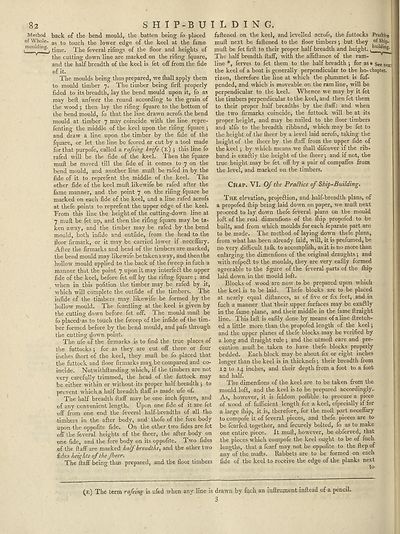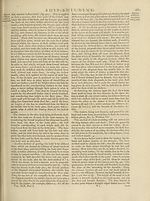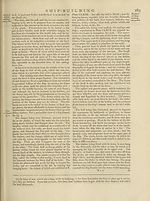Encyclopaedia Britannica, or, a Dictionary of arts, sciences, and miscellaneous literature : enlarged and improved. Illustrated with nearly six hundred engravings > Volume 19, Scripture-SUG
(300) Page 282
Download files
Complete book:
Individual page:
Thumbnail gallery: Grid view | List view

82 SHI P-B U I L D I N G.
Method back of the bend mould, the batten being fo placed
of Whole- as tf) toucb the lower edge of the keel at the fame
t —_l11^'. time. The feveral rilings of the floor and heights of
the cutting down line are marked on the rifing fquare,
and the half breadth of the keel is fet off from the fide
of it.
The moulds being thus prepared, we (hall apply them
to mould timber 7. The timber being firft properly
fided to its breadth, lay the bend mould upon it, fo as
may beft anfwer the round according to the grain of
the wood } then lay the rifing fquare to the bottom of
the bend mould, fo that the line drawn acrofs the bend
mould at timber 7 may coincide with the line repre-
fenting the middle of the keel upon the rifing fquare \
and draw a line upon the timber by the fide of the
fquare, or let the line be fcored or cut by a tool made
for that purpofe, called a rafeing knife (e) j this line fo
rafed will be the fide of the keel. Then the fquare
muft be moved till the fide of it comes to 7 on the
bend mould, and another line muft be rafed in by the
fide of it to reprefent the middle of the keel. The
other fide of the keel mufi. likewife be rafed after the
fame manner, and the point 7 on the rifing fquare be
marked on each fide of the keel, and a line rafed acrofs
at thefe points to reprefent the upper edge of the keel.
From this line the height of the cutting-down line at
7 muft be fet up, and then the rifing fquare may be ta¬
ken away, and the timber may be rafed by the bend
mould, both infide and outfide, from the head to the
floor firmark, or it may be carried lower if neceffary.
After the firmarks and head of the timbers are marked,
the bend mould may likewife betakenaway, and thenthe
hollow mould applied to the back of the fweep in fuch a
manner that the point 7 upon it may interfeft the upper
fide of the keel, before fet off by the rifing fquare ; and
Avhen in this pofition the timber may be rafed by it,
•which will cotnplete the outfide of the timbers. The
infide of the timbers may likewife be formed by the
hollow mould. The fcantling at the keel is given by
the cutting down before fet off. I he mould muft be
fo placed as to touch the fweep of the infide of the tim¬
ber formed before by the bend mould, and pafs through
the cutting down point.
The ufe of the firmarks Is to find the true places of
the futtocks ; for as they are cut oflf three or four
inches ftiort of the keel, they muft be fo placed that
the futtock and floor firmarks may be compared and co¬
incide. Notwithftanding which, if the timbers are not
very carefully trimmed, the head of the futtock may
be either within or without its proper half breadth ; to
prevent which a half breadth ftaff is made ufe of.
The half breadth ftaff may be one inch fquare, and
of any convenient length. Upon one fide of it are fet
off from one end the feveral half-breadths of all the
timbers in the after body, and thofe of the fore body
upon the oppofite fide. On the other two fides are let
off the feveral heights of the ftieer, the after body on
one fide, and the fore body on its oppofite. Two fides
of the ft aff are marked half breadths, and the other two
fides heights of the Jheer.
The ftaft' being thus prepared, and the floor timbers
faftened on the keel, and levelled acrofs, the futtocks Pra&rce
muft next be faftened to the floor timbers j but they Ship,
muft be fet firft to their proper half breadth and height., u^‘ng^
The half breadth ftaff, with the afliftance of the ram¬
line *, ferves to fet them to the half breadth j for as * See nexJ
the keel of a boat is generally perpendicular to the ho-chapter,
rizon, therefore the line at which the plummet is fuf-
pended, and which is moveable on the ram line, will be
perpendicular to the keel. Whence we may by it fet
the timbers perpendicular to the keel, and then fet them
to their proper half breadths by the ftaff: and when
the two firmarks coincide, the futtock will be at its
proper height, and may be nailed to the floor timbers
and alfo to the breadth ribband, which may be fet to
the height of the ftieer by a level laid acrofs, taking the
height of the ftieer by the ftaff from the upper fide of
the keel j by which means we fliall difcover if the rib¬
band is exactly the height of the flieer; and if not, the
true height may be fet off by a pair of compaffes from
the level, and marked on the timbers.
Chap. VI. Of the Practice of Ship-Building.
The elevation, projeftion, and half-breadth plans, of
a propofed ftiip being laid down on paper, we muft next
proceed to lay down thefe feveral plans on the mould
loft of the real dimenfions of the fliip propofed to be
built, and from which moulds for each feparate part are
to be made. The method of laying down thefe plans,
from what has been already faid, will, it is prefumed, be
no very difficult talk to accompliffi, as it is no more than
enlarging the dimenfions of the original draughts; and
with refpect to the moulds, they are very eafily formed
agreeable to the figure of the feveral parts of the ffiip
laid down in the mould loft.
Blocks of wood are now to be prepared upon which
the keel is to be laid. Thefe blocks are to be placed
at nearly equal diftances, as of five or fix feet, and in
fuch a manner that their upper furfaces may be exadlly
in the fame plane, and their middle in the fame ftraight
line. This laft is eafily done by means of a line ftretch-
ed a little more than the propofed length of the keel j
and the upper planes of thefe blocks may be verified by
a long and ftraight rule; and the utmoft care and pre¬
caution muft be taken to have thefe blocks properly
bedded. Each block may be about fix or eight inches
longer than the keel is in thicknefs; their breadth from
12 to 14 inches, and their depth from a foot to a foot
and half.
The dimenfions of the keel are to be taken from the
mould loft, and the keel is to be prepared accordingly.
As, however, it is feldom poflible to procure a piece
of wood of fufficient length for a keel, efpecially if for
a large fliip, it is, therefore, for the moft part neceffary
to compofe it of feveral pieces, and thefe pieces are to
be fcarfed together, and fecurely bolted, fo as to make
one entire piece. It muft, however, be obferved, that
the pieces which compofe the keel ought to be of fuch
lengths, that a fcarf may not be oppofite to the ftep of
any of the mafts. Rabbets are to be formed on each
fide of the keel to receive the edge of the planks next
to
The term rafeing is ufed when any line is drawn by fqch an inftrument inftead of a pencil.
3
Method back of the bend mould, the batten being fo placed
of Whole- as tf) toucb the lower edge of the keel at the fame
t —_l11^'. time. The feveral rilings of the floor and heights of
the cutting down line are marked on the rifing fquare,
and the half breadth of the keel is fet off from the fide
of it.
The moulds being thus prepared, we (hall apply them
to mould timber 7. The timber being firft properly
fided to its breadth, lay the bend mould upon it, fo as
may beft anfwer the round according to the grain of
the wood } then lay the rifing fquare to the bottom of
the bend mould, fo that the line drawn acrofs the bend
mould at timber 7 may coincide with the line repre-
fenting the middle of the keel upon the rifing fquare \
and draw a line upon the timber by the fide of the
fquare, or let the line be fcored or cut by a tool made
for that purpofe, called a rafeing knife (e) j this line fo
rafed will be the fide of the keel. Then the fquare
muft be moved till the fide of it comes to 7 on the
bend mould, and another line muft be rafed in by the
fide of it to reprefent the middle of the keel. The
other fide of the keel mufi. likewife be rafed after the
fame manner, and the point 7 on the rifing fquare be
marked on each fide of the keel, and a line rafed acrofs
at thefe points to reprefent the upper edge of the keel.
From this line the height of the cutting-down line at
7 muft be fet up, and then the rifing fquare may be ta¬
ken away, and the timber may be rafed by the bend
mould, both infide and outfide, from the head to the
floor firmark, or it may be carried lower if neceffary.
After the firmarks and head of the timbers are marked,
the bend mould may likewife betakenaway, and thenthe
hollow mould applied to the back of the fweep in fuch a
manner that the point 7 upon it may interfeft the upper
fide of the keel, before fet off by the rifing fquare ; and
Avhen in this pofition the timber may be rafed by it,
•which will cotnplete the outfide of the timbers. The
infide of the timbers may likewife be formed by the
hollow mould. The fcantling at the keel is given by
the cutting down before fet off. I he mould muft be
fo placed as to touch the fweep of the infide of the tim¬
ber formed before by the bend mould, and pafs through
the cutting down point.
The ufe of the firmarks Is to find the true places of
the futtocks ; for as they are cut oflf three or four
inches ftiort of the keel, they muft be fo placed that
the futtock and floor firmarks may be compared and co¬
incide. Notwithftanding which, if the timbers are not
very carefully trimmed, the head of the futtock may
be either within or without its proper half breadth ; to
prevent which a half breadth ftaff is made ufe of.
The half breadth ftaff may be one inch fquare, and
of any convenient length. Upon one fide of it are fet
off from one end the feveral half-breadths of all the
timbers in the after body, and thofe of the fore body
upon the oppofite fide. On the other two fides are let
off the feveral heights of the ftieer, the after body on
one fide, and the fore body on its oppofite. Two fides
of the ft aff are marked half breadths, and the other two
fides heights of the Jheer.
The ftaft' being thus prepared, and the floor timbers
faftened on the keel, and levelled acrofs, the futtocks Pra&rce
muft next be faftened to the floor timbers j but they Ship,
muft be fet firft to their proper half breadth and height., u^‘ng^
The half breadth ftaff, with the afliftance of the ram¬
line *, ferves to fet them to the half breadth j for as * See nexJ
the keel of a boat is generally perpendicular to the ho-chapter,
rizon, therefore the line at which the plummet is fuf-
pended, and which is moveable on the ram line, will be
perpendicular to the keel. Whence we may by it fet
the timbers perpendicular to the keel, and then fet them
to their proper half breadths by the ftaff: and when
the two firmarks coincide, the futtock will be at its
proper height, and may be nailed to the floor timbers
and alfo to the breadth ribband, which may be fet to
the height of the ftieer by a level laid acrofs, taking the
height of the ftieer by the ftaff from the upper fide of
the keel j by which means we fliall difcover if the rib¬
band is exactly the height of the flieer; and if not, the
true height may be fet off by a pair of compaffes from
the level, and marked on the timbers.
Chap. VI. Of the Practice of Ship-Building.
The elevation, projeftion, and half-breadth plans, of
a propofed ftiip being laid down on paper, we muft next
proceed to lay down thefe feveral plans on the mould
loft of the real dimenfions of the fliip propofed to be
built, and from which moulds for each feparate part are
to be made. The method of laying down thefe plans,
from what has been already faid, will, it is prefumed, be
no very difficult talk to accompliffi, as it is no more than
enlarging the dimenfions of the original draughts; and
with refpect to the moulds, they are very eafily formed
agreeable to the figure of the feveral parts of the ffiip
laid down in the mould loft.
Blocks of wood are now to be prepared upon which
the keel is to be laid. Thefe blocks are to be placed
at nearly equal diftances, as of five or fix feet, and in
fuch a manner that their upper furfaces may be exadlly
in the fame plane, and their middle in the fame ftraight
line. This laft is eafily done by means of a line ftretch-
ed a little more than the propofed length of the keel j
and the upper planes of thefe blocks may be verified by
a long and ftraight rule; and the utmoft care and pre¬
caution muft be taken to have thefe blocks properly
bedded. Each block may be about fix or eight inches
longer than the keel is in thicknefs; their breadth from
12 to 14 inches, and their depth from a foot to a foot
and half.
The dimenfions of the keel are to be taken from the
mould loft, and the keel is to be prepared accordingly.
As, however, it is feldom poflible to procure a piece
of wood of fufficient length for a keel, efpecially if for
a large fliip, it is, therefore, for the moft part neceffary
to compofe it of feveral pieces, and thefe pieces are to
be fcarfed together, and fecurely bolted, fo as to make
one entire piece. It muft, however, be obferved, that
the pieces which compofe the keel ought to be of fuch
lengths, that a fcarf may not be oppofite to the ftep of
any of the mafts. Rabbets are to be formed on each
fide of the keel to receive the edge of the planks next
to
The term rafeing is ufed when any line is drawn by fqch an inftrument inftead of a pencil.
3
Set display mode to:
![]() Universal Viewer |
Universal Viewer | ![]() Mirador |
Large image | Transcription
Mirador |
Large image | Transcription
Images and transcriptions on this page, including medium image downloads, may be used under the Creative Commons Attribution 4.0 International Licence unless otherwise stated. ![]()
| Permanent URL | https://digital.nls.uk/192699182 |
|---|
| Attribution and copyright: |
|
|---|
| Description | Ten editions of 'Encyclopaedia Britannica', issued from 1768-1903, in 231 volumes. Originally issued in 100 weekly parts (3 volumes) between 1768 and 1771 by publishers: Colin Macfarquhar and Andrew Bell (Edinburgh); editor: William Smellie: engraver: Andrew Bell. Expanded editions in the 19th century featured more volumes and contributions from leading experts in their fields. Managed and published in Edinburgh up to the 9th edition (25 volumes, from 1875-1889); the 10th edition (1902-1903) re-issued the 9th edition, with 11 supplementary volumes. |
|---|---|
| Additional NLS resources: |
|

